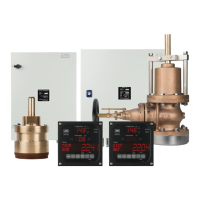with accurate gyro data, the two-dimensional ”dead reckoning” performed by the navigation computer
can be directly compared with other position data and the angular error produced by the log can be
calculated directly or indirectly.
For most installations. however, this is not possible, and the following procedure is proposed:
a) Place the ship on a straight course directly against current and wind so that the true transversal
motion of the ship is zero.
b) Read the transversal speed output of the log as the same time as the transducer is accessible (the
transversal speed can for instance be read on an NMEA output of NQA-4480).
c) Trim the transducer angle until the transversal speed reading fluctuations are centred around zero.
(this is described in the section ”Installation of transducer and bottom parts”.)
Where it is necessary to perform a software calibration of the transducer angle, some reference system
to establish the desired correction angle must be used. The accuracy of this system must be verified.
The following formula can be used:
)
NEW
= )
OLD
+ 4
measured
- 4
reference
,
where 4
reference
is the direction of movement (referenced to the keel line) obtained from the reference
system and 4
measured
is the same direction obtained from the log during the trial run. The angular
values for both reference system and log output can be found using the relationship:
4 = arctan (D
t
/ D
l
),
where D
t
is the transversal distance (or speed) component and D
l
is the longitudinal component.
The angular correction ”)” entered on the thumbwheel switches are represented in 0.1° steps, using
menu C2.
3.2 Speed Calibration (SOG)
It is possible to calibrate the speed value with a correction factor in 0.01% increments.
However, for most installations, where the transducer is installed exactly vertical and where normal
reference systems, like DGPS or other electronic navigation systems, are used it is not
necessary/possible to get improved performance by calibrating the log.
If good enough reference data are possible to obtain, the calibration value to be set in the system can
be calculated using the following formula:
BScale
NEW
= BScale
OLD
x D
expected
/ D
sensed
where BScale
NEW
is the new absolute value and BScale
OLD
is the old value that was set during the
distance run. Note that values in the menu system are relative in percent and the formula uses absolute
values.
13-4

